How to Overhaul a Kodak Brownie Target Six-20
So, you've inherited, bought, or found a Kodak Brownie Target Six-20 from some source. Now how do you prepare it for use? Fear not, this brief and pithy tutorial will show you how, more or less.
To begin, you'll need several tools you no doubt have in your toolkit:
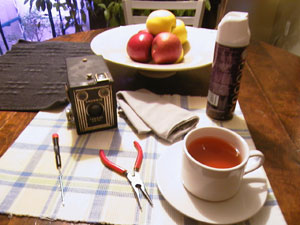 The cup of tea is not optional. Jasmin sweetened with honey is recommended, but Earl Grey should form a nice substitute. This may come as a shock to those who are familiar with the author, but in no case should you drink coffee while performing the following. Now, take some time to admire the details of the instrument you are about to perform surgery upon.
The cup of tea is not optional. Jasmin sweetened with honey is recommended, but Earl Grey should form a nice substitute. This may come as a shock to those who are familiar with the author, but in no case should you drink coffee while performing the following. Now, take some time to admire the details of the instrument you are about to perform surgery upon.
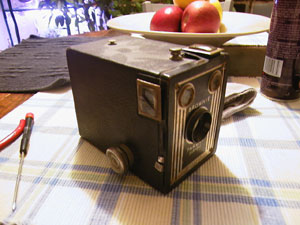
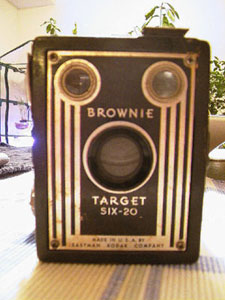 All done? Good. Now you will need to loose the catch on top after pulling out the winding knob. This will allow you to pull the body of the camera from its shell, resulting in something like this:
All done? Good. Now you will need to loose the catch on top after pulling out the winding knob. This will allow you to pull the body of the camera from its shell, resulting in something like this:
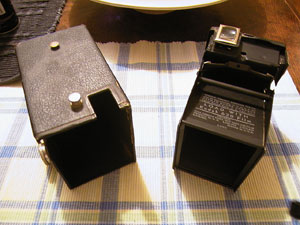 Have a few sips of tea while you admire the mechanical beauty you have exposed. Go ahead, the Internet can wait.
Have a few sips of tea while you admire the mechanical beauty you have exposed. Go ahead, the Internet can wait.
Right then, now it's time to get down to business. There are four small screws on the front of the body which you'll need to remove using a jeweler's screwdriver. Be careful, as these screws likely haven't been free since Ike was in the White House. You will then want to prise the brilliant viewfinders from the body very carefully. These are basically wedged in place, so careful application of your needlenose pliers and some perseverance will pay off.
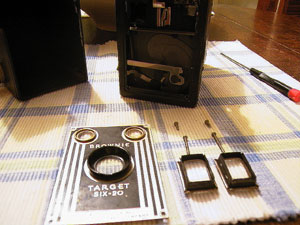 At this point you will want to go to town with the cleaner of your choice on the viewfinders, their mirrors, the lens, and the interior of the body. An electronic equipment cleaner and a microfiber cloth was used for this treatise, but to be very clear, it is contraindicated to use paper towels and water. You should not expend too much effort on cleaning the camera, since the particles floating about inside add a certain patina to your shots, which, after all, is the reason you use an old box camera, right? Right.
At this point you will want to go to town with the cleaner of your choice on the viewfinders, their mirrors, the lens, and the interior of the body. An electronic equipment cleaner and a microfiber cloth was used for this treatise, but to be very clear, it is contraindicated to use paper towels and water. You should not expend too much effort on cleaning the camera, since the particles floating about inside add a certain patina to your shots, which, after all, is the reason you use an old box camera, right? Right.
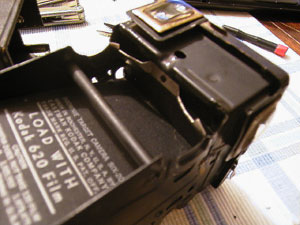 Now, take a close look at the top of the body where the supply of film is stored. It is here that some serious work will commence. Kodak, in its infinite wisdom, invented the 620 film format to replace the 120 format in common use back in the early 20th century. As with the Betamax, however, creating a better product did not ensure its longevity, and the 620 format went the way of the dodo while 120 remains available to this day. The difference between these formats is highly debated by photophiles with more time on their hands than the author, suffice it to say that 120 is a few millimeters greater in diameter and length.
Now, take a close look at the top of the body where the supply of film is stored. It is here that some serious work will commence. Kodak, in its infinite wisdom, invented the 620 film format to replace the 120 format in common use back in the early 20th century. As with the Betamax, however, creating a better product did not ensure its longevity, and the 620 format went the way of the dodo while 120 remains available to this day. The difference between these formats is highly debated by photophiles with more time on their hands than the author, suffice it to say that 120 is a few millimeters greater in diameter and length.
There are many methods available to get 120 film into your 620 camera. If you want to leave your camera untouched and pristine (picky, aren't we?), then you will want to get ahold of some old 620 spools and then laboriously respool the 120 film onto them prior to each photo-excursion. This author, being a lazy sort, prefers the following: widening the supply space and shortening the film spool. Look closely at the space where your film would be loaded on top and notice the indentation on either side:
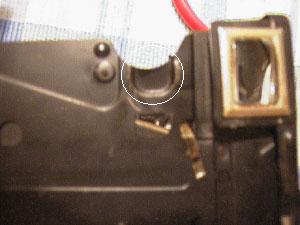 Using a clamp you will attempt to flatten out this dent. If your clamps are substandard as the author's were, this attempt will only slightly enlarge the total space for your film. To get the extra distance you will need to saw the ends of the film off in a dark place (or not, it shouldn't introduce too much light to the film). One caveat: you should not perform the sawing over one of your kitchen placemats. In creating this article, this produced a hole in said placemat and a, thankfully, bemused spouse, but you may not find yourself as lucky as the author. When you are all finished, your workspace may or may not resemble this:
Using a clamp you will attempt to flatten out this dent. If your clamps are substandard as the author's were, this attempt will only slightly enlarge the total space for your film. To get the extra distance you will need to saw the ends of the film off in a dark place (or not, it shouldn't introduce too much light to the film). One caveat: you should not perform the sawing over one of your kitchen placemats. In creating this article, this produced a hole in said placemat and a, thankfully, bemused spouse, but you may not find yourself as lucky as the author. When you are all finished, your workspace may or may not resemble this:
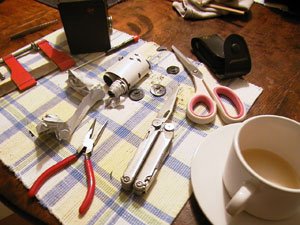 Photos taken using this newly-modified machine to follow. Cheers!
Photos taken using this newly-modified machine to follow. Cheers!
To begin, you'll need several tools you no doubt have in your toolkit:
 The cup of tea is not optional. Jasmin sweetened with honey is recommended, but Earl Grey should form a nice substitute. This may come as a shock to those who are familiar with the author, but in no case should you drink coffee while performing the following. Now, take some time to admire the details of the instrument you are about to perform surgery upon.
The cup of tea is not optional. Jasmin sweetened with honey is recommended, but Earl Grey should form a nice substitute. This may come as a shock to those who are familiar with the author, but in no case should you drink coffee while performing the following. Now, take some time to admire the details of the instrument you are about to perform surgery upon.
 All done? Good. Now you will need to loose the catch on top after pulling out the winding knob. This will allow you to pull the body of the camera from its shell, resulting in something like this:
All done? Good. Now you will need to loose the catch on top after pulling out the winding knob. This will allow you to pull the body of the camera from its shell, resulting in something like this: Have a few sips of tea while you admire the mechanical beauty you have exposed. Go ahead, the Internet can wait.
Have a few sips of tea while you admire the mechanical beauty you have exposed. Go ahead, the Internet can wait.Right then, now it's time to get down to business. There are four small screws on the front of the body which you'll need to remove using a jeweler's screwdriver. Be careful, as these screws likely haven't been free since Ike was in the White House. You will then want to prise the brilliant viewfinders from the body very carefully. These are basically wedged in place, so careful application of your needlenose pliers and some perseverance will pay off.
 At this point you will want to go to town with the cleaner of your choice on the viewfinders, their mirrors, the lens, and the interior of the body. An electronic equipment cleaner and a microfiber cloth was used for this treatise, but to be very clear, it is contraindicated to use paper towels and water. You should not expend too much effort on cleaning the camera, since the particles floating about inside add a certain patina to your shots, which, after all, is the reason you use an old box camera, right? Right.
At this point you will want to go to town with the cleaner of your choice on the viewfinders, their mirrors, the lens, and the interior of the body. An electronic equipment cleaner and a microfiber cloth was used for this treatise, but to be very clear, it is contraindicated to use paper towels and water. You should not expend too much effort on cleaning the camera, since the particles floating about inside add a certain patina to your shots, which, after all, is the reason you use an old box camera, right? Right. Now, take a close look at the top of the body where the supply of film is stored. It is here that some serious work will commence. Kodak, in its infinite wisdom, invented the 620 film format to replace the 120 format in common use back in the early 20th century. As with the Betamax, however, creating a better product did not ensure its longevity, and the 620 format went the way of the dodo while 120 remains available to this day. The difference between these formats is highly debated by photophiles with more time on their hands than the author, suffice it to say that 120 is a few millimeters greater in diameter and length.
Now, take a close look at the top of the body where the supply of film is stored. It is here that some serious work will commence. Kodak, in its infinite wisdom, invented the 620 film format to replace the 120 format in common use back in the early 20th century. As with the Betamax, however, creating a better product did not ensure its longevity, and the 620 format went the way of the dodo while 120 remains available to this day. The difference between these formats is highly debated by photophiles with more time on their hands than the author, suffice it to say that 120 is a few millimeters greater in diameter and length.There are many methods available to get 120 film into your 620 camera. If you want to leave your camera untouched and pristine (picky, aren't we?), then you will want to get ahold of some old 620 spools and then laboriously respool the 120 film onto them prior to each photo-excursion. This author, being a lazy sort, prefers the following: widening the supply space and shortening the film spool. Look closely at the space where your film would be loaded on top and notice the indentation on either side:
 Using a clamp you will attempt to flatten out this dent. If your clamps are substandard as the author's were, this attempt will only slightly enlarge the total space for your film. To get the extra distance you will need to saw the ends of the film off in a dark place (or not, it shouldn't introduce too much light to the film). One caveat: you should not perform the sawing over one of your kitchen placemats. In creating this article, this produced a hole in said placemat and a, thankfully, bemused spouse, but you may not find yourself as lucky as the author. When you are all finished, your workspace may or may not resemble this:
Using a clamp you will attempt to flatten out this dent. If your clamps are substandard as the author's were, this attempt will only slightly enlarge the total space for your film. To get the extra distance you will need to saw the ends of the film off in a dark place (or not, it shouldn't introduce too much light to the film). One caveat: you should not perform the sawing over one of your kitchen placemats. In creating this article, this produced a hole in said placemat and a, thankfully, bemused spouse, but you may not find yourself as lucky as the author. When you are all finished, your workspace may or may not resemble this: Photos taken using this newly-modified machine to follow. Cheers!
Photos taken using this newly-modified machine to follow. Cheers!

2 Comments:
Beaut! Follow up with pictures from the Brownie is a must, to show the world whether or not all the effort (and torn placemats) are worth one's while.
Due to rain I was only able to take part of a roll today on an outing to Harper's Ferry, WVA, but I plan to finish the rest of it by the end of the week, weather allowing.
Post a Comment
<< Home